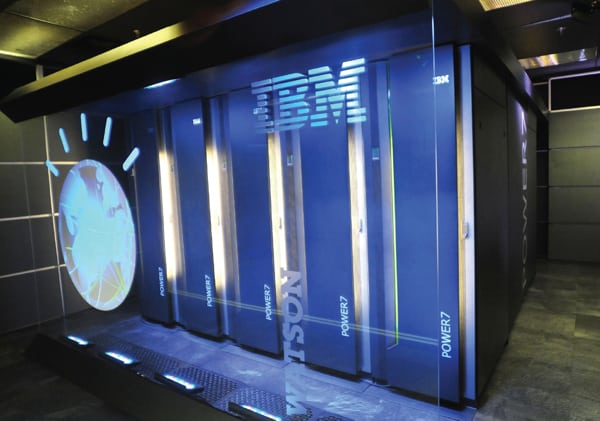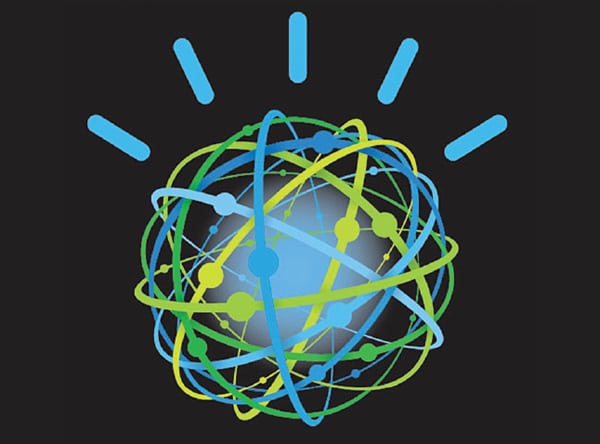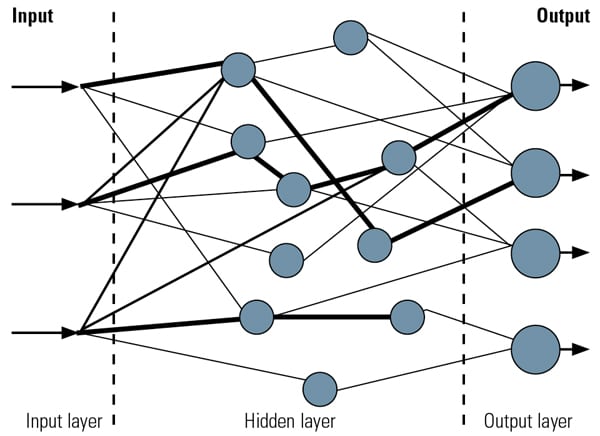Artificial Intelligence Boosts Plant IQ
 |
| Courtesy: IBM |
Neural networks have already found practical application in many plants, and recent advancements in artificial intelligence promise to shape the design of the next generation of power plant supervisory controls. Will future plant operators be fashioned from silicon?
In February, viewers of the quiz show Jeopardy! watched as IBM’s supercomputer Watson soundly defeated the all-time game show champions Ken Jennings and Brad Rutter. Watson’s victory has been viewed by those who work in the field of information technology (IT) as a milestone event. The game show victory marked the first time a machine had sufficient data recollection speed, discernment accuracy, and reliability to compete with humans in a real-time test of judgment and knowledge, and win.
Watson not only retrieved data quickly, like many of today’s popular Internet search engines, but the supercomputer also assessed the available data and made a judgment as to the most appropriate answer (Figure 1). This success was not based on a single computer program; instead, it required many programs working in parallel to achieve an elementary level of artificial intelligence (AI).
 |
| 1. Watson’s avatar. Watson, named after IBM founder Thomas J. Watson, was built by a team of IBM scientists who set out to accomplish a grand challenge: build a computing system that rivals a human’s ability to answer questions posed in natural language with speed, accuracy, and confidence. The Jeopardy! format provided the ultimate challenge because the game’s clues involve analyzing subtle meaning, irony, riddles, and other language complexities in which humans excel and computers traditionally do not. Courtesy: IBM |
Does this singular computational victory of machine over man have implications for the design of control systems for future power plants? To capitalize on AI technology in the future, we need to look beyond how IT is used in power facilities today and leverage long-established advanced distributed controls platforms to support virtual plant operations. The implications of doing so could be significant and range from minimizing, or even eliminating, human factors engineering issues in plant operations to allowing hyper-performance optimization that promises significant operating cost savings.
The Future Is Forward
To get a good understanding of where we might leverage Watson-like technology advancements in the future, we need to quickly review the history of power plant control development.
Power generation is generally a very conservative industry when it comes to accepting new technology. This stance is justified by the critical nature of the product that must be supplied instantly, continuously, and with very high reliability. However, simply relying only on fully mature technology, as is our habit, may result in a significant lost opportunity to modernize the power generation infrastructure. Technology advancements are already under way with many smart grid projects that promise to improve the process and cost of delivering electricity. Similarly, new and emerging technologies that leverage IT should be considered when planning for future power plant controls.
As a major international engineering, procurement, construction and commissioning firm and technology integrator for gas-fueled, solid-fueled, and nuclear power facilities, Fluor Corp. has had the unique opportunity to work with just about all major suppliers for power plant distributed control systems (DCSs), programmable logic controllers, instrumentation/automation, and network components communicating in various protocols over a range of different control system architectures. Two previous articles (“Digital Networks Prove Reliable, Reduce Costs,” July 2009 and “TS Power Plant, Eureka County, Nevada,” October 2008, available in POWER’ s archives at https://www.powermag.com) reviewed what are generally considered to be state-of-the-art digital control power system designs.
Artificial Intelligence Primer
In very simplistic terms, AI enables computers to think like humans to solve problems. When applied to power facilities, AI, perhaps more correctly called intelligent control, collects data from the plant and, when combining that data with stored data from library resources, is able to “learn” the appropriate response based on a predetermined desired state or some external request to achieve another state of operation. Many researchers consider systems that learn from their actions and make good decisions with incomplete information as having a form of artificial intelligence.
Neural networks take inputs from the environment and process them to determine patterns and relationships and then point to a directed output (Figure 2). In human intelligence, neurons in our brains learn how to respond to daily stimuli. Neural networks allow computers to artificially mimic this same process recognition and classification of data. The AI neurons are connected by varying strengths (as represented by various line weights in the figure).
 |
| 2. Capturing experience. Neural networks artificially mimic the human brain in process recognition and classification of data. The complexity of the stimuli (input) determines the number and strength of the pathways (illustrated by line weight) that determine the result (output). Processing numerous connections in parallel and keeping track of the results allows the neural network to learn from “experience.” Source: Fluor Corp. |
Although the diagram is simplistically shown in two dimensions, there are actually multiple layers—in space and time—for the connections. Depending on the complexity of the stimuli, there could be a few connections or an extensive network of connections. Processing numerous connections in parallel and keeping track of the results allows the neural network to “learn” from experience and store or memorize the end result. The network can subsequently retrieve millions of prior experiences quickly to make value judgments in similar circumstances in the future.
Classical control systems have been processing data and determining outputs for quite some time. Conventional control practices work best when the systems are not overly complex. These control systems rely on alarms to ensure operator notification if the process is approaching or achieves an “out-of-control” or abnormal state.
The more complex the application and the more diverse the conditions under which it operates, the more complicated the control system becomes. When the process being controlled is very complex and has to operate under a wide range of conditions and disturbances, AI technology enhances classical control theory techniques. This type of control, based on AI layering, is referred to as intelligent control. Incorporating AI into control systems allows these systems to be more flexible, to adapt to various operating conditions and disturbances, and to incorporate human expertise and thinking into their decision-making process.
AI terminology has been somewhat foreign to the power industry. The lines between classical control and AI are sometimes blurred. Familiar fuzzy logic design is an area where classical controls have incorporated elements of AI.
Data Proliferation
At the core of intelligence is raw data. For power generating facilities, we have seen an exponential increase in available plant data stored in plant databases and historians. This growth in data has come from many different sources.
The first source is the general growth in plant automation as distributed control systems replaced manual plant controls. Another source of growth in data has been from the advancement of predictive and preventive maintenance in power stations. As digital communications have spread throughout the design architecture of new facilities, more data is more easily accessible, and this has led to significant increases in available data sources or inputs. Finally, in our current state of interactive human/nonhuman controls, significant data is collected through plant alarm systems designed to assist operations when the plant is outside of the normal bounds of control. Those situations can present significant challenges to operators if the alarms are not properly managed through prioritization and filtering of extraneous or duplicate alarms.
In addition to the growth in field data collected, volumes of data from the many components that make up today’s modern power plant are available as resource information. This data sometimes includes initial checkout and testing data, preventive maintenance requirements, maintenance records, and equipment operating curves.
As an example of how voluminous the data can be in state-of-the-art plant control systems, Fluor recently completed a 2 x 800-MW supercritical coal facility that includes more than 15,000 physical instrument tags. This facility incorporates some of the most advanced control bus technologies. Over 70% of the more than 30,000 total plant inputs and outputs (I/Os) are digital. More than 8,000 alarms are programmed into the DCS controls.
Artificial Neural Networks
As more and more actions in power plants have become automated, control hardware and software have advanced. Today’s open structure DCS gives programmers a more user-friendly interface into which they can incorporate control philosophies that are very complex and sophisticated. Advances in controls technology have added many functional capabilities to new control systems while expanding the complexity of the processes managed and the potential span of control.
Although proportional-integral-derivative (PID) control has not significantly changed in 25 years, there has been significant advancement in the hardware and software to support the faster processing speeds and increased reliability necessary for today’s plant environments. As the amount of available plant data grows and the pressure to incorporate complex optimization technology increases, classical controls will quickly reach the limit of their capabilities.
For the power generation industry, rule-based AI neural networks can be applied in at least three ways: in grassroots neural networks, neural network oversight of conventional or classical controls, and neural network oversight of conventional classical controls in specific application areas of plant control.
Grassroots Neural Networks. Compared with other process industries, the power industry typically takes a more conservative approach when it comes to the introduction of new, unproven technologies. For example, digital bus controls have slowly been introduced into the industry over the past decade. Fluor implemented many of this industry’s first fieldbus instruments almost two decades ago in a number of combined-cycle power plants. At the time, the fieldbus instruments were limited primarily to monitoring functions, because their use in process controls was considered as having technology risks. Today, Fluor has completed facilities in which greater than 70% of the plant I/Os are transmitted on digital bus networks.
The process of gaining widespread acceptance of making a new, grassroots neural network part of the design of a new power facility may be slow and arduous.
Neural Network Watchdog. Perhaps a more likely scenario for widespread implementation of AI in power generation is a neural network that can essentially “sit on top” of a plant’s existing DCS. Such an AI system will monitor, learn, and make value judgments about potential changes in state to optimize plant operation in order to improve safety or, perhaps, plant reliability. These artificial neural networks are relatively mature and commercially available today.
With the growth in automation in power generation facilities, the incredible complexity of monitoring plant operations, noting anomalies, diagnosing those anomalies, and taking action in a timely manner can quickly become unwieldy and unmanageable using conventional controls technology. On the other hand, artificial neural systems can “view” numerous process variables almost instantly, recognize trends or deteriorating conditions or opportunities to improve conditions, review a library for potential reactions, and make weighted judgments on the best action. The result can be significant benefits to plant operations.
The neural network systems offered by some of the major process technology providers are open systems that work with various suppliers’ DCS platforms. These commercial systems are available to automatically make decisions to optimize performance of a plant subsystem, such as combustion controls. AI systems can also be configured to act as an operator consultant—a decision-support system—to make recommendations on operating adjustments.
Targeted Process Neural Network Watchdog. AI systems currently used in power plants are usually targeted to specific application areas of process control such as combustion optimization or plant performance. Much as with the advance of digital controls, this stepwise adoption of the technology provides sufficient testing to make users comfortable with the intelligent algorithms without exposing early AI system adopters to the risk of reduced plant reliability.
Already, numerous operating plants incorporate some form of targeted neural networks. Some plants have used some form of AI-based controls to reduce NOx production and to optimize their boiler cleaning or sootblowing systems. Some of the applications have years of operating experience at power generation facilities.
Watson as Your Virtual Plant Operator
Claims of improvements up to 1.5% in plant heat rate, reductions in emissions levels, improvements in equipment availability, improvements in steam turbine ramp rates, and improvements in start-up efficiencies are all claims made by vendors of AI networks. The promised benefits are significant, but there are consequences to moving forward on AI-based plant controls.
Critics of AI systems are quick to point out the potential vulnerabilities that are introduced with regard to cybersecurity when so many systems are operating over plant networks (voice over Internet protocol, security, plant network, operations network, and the like). This is a significant issue that warrants study, particularly in light of recent North American Electric Reliability Corp. requirements for Critical Infrastructure Protection. Network defense systems and monitoring are sufficient to protect against unwanted intrusions, but clearly, widespread implementation of AI at power plants may make control networks more vulnerable.
Another consideration is that AI-based control systems “learn” from prior experiences. Any system will require time to “think” through the innumerable possible combinations of process variables and operating scenarios before it matures and develops a library of operating scenarios and responses. The system will also require clear exit paths and mitigation programs should its complex networks get “stumped.”
Finally, expect some resistance to accepting AI-based controls at a more philosophical level. Some system designers believe that intelligent control systems have the potential to breed a culture of superficial knowledge. Today, many plants can still be operated manually by experienced operators. When, in the future, reliance on AI systems is the norm, what will be the motivation to push for more understanding of the operating nuances and situational responses necessary when operating a plant? Will the hands-on operator become obsolete?
On the other hand, the adoption of intelligent systems may be one solution to the expected loss of a vast amount of operating knowledge as the baby boomer generation approaches retirement age. How to capture that knowledge remains problematic and is the subject of current research.
What we have learned so far is that Watson has proven to be a great game show player. But we also know that it (he?) is not ready to operate a major power generation facility… yet.
— James H. Brown, PE, PMP ([email protected]) is senior director of engineering for Fluor Corp.’s Power Group.